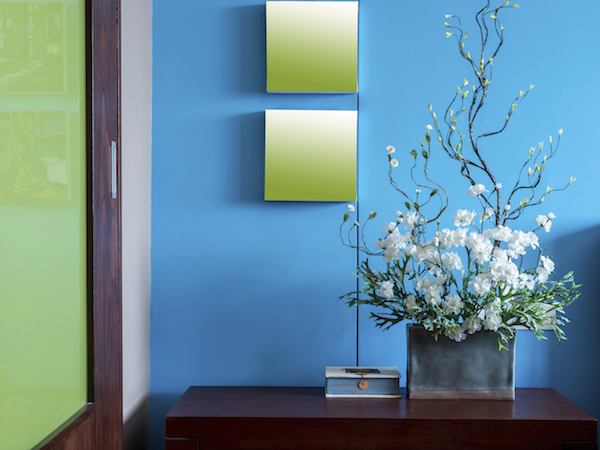
Contrasting walls in bright colors can change the temperament of a room. Bright, vibrant colors give a room energy.
Color accounts for 50 percent of our responses to an object or place, according to research, so choosing the right color for your living space could mean the difference between a feeling of cozy happiness and one of discomfort. Choosing the right color for you takes a lot more these days than just asking for blue or white paint. Within each color band, exist hundreds of varieties from “Twilight Blue” to “I Dream I Can Fly.” (Yes, that last one is actually a name of a paint color from Benjamin Moore.) If picking paint colors raises your blood pressure, check out these nine tips for making it a little easier:
1. Like it first
Before you head to the paint store, pick a color you already know and love in something you already have. New computerized paint mixers can match any color on just about any object you can drag into the shop.
2. Paint a portion
Paint a small part of your room or an outdoor wall, whatever you are painting, and see if you like it before committing to buying by the gallon. You might even want to live with it a few days before making a final decision. Even less of a commitment would be to paint a poster board and hang it in the room.
3. Seize the mood
Decide the mood of the room you are painting. Bedrooms should feel restful and soothing, a dining area should be sociable and stimulating. You might want a vibrant kitchen or one that looks productive and industrial. If you are looking for excitement in a room, go for warm, bright colors. Restful and soothing room colors should be picked from the cool, pastel palettes.
4. Consider the lighting
Natural daylight shows the truest colors, while incandesent lighting brings out the warm tones and yellows. Fluorescent lightings creates a sharp blue tone. See if your paint store has a light box for you to use when comparing paint chips, and consider the type of lighting that will be most dominant in the room.
5. Learn the lingo
Hue is the color, while saturation refers to how dark or light the color is. Intensity refers to the brilliance factor in color. For a more active space, you’ll want more intense color. For light-colored rooms, consider colors that are more saturated, off-white or light pastel. They won’t feel so stark or bright.
6. Think outside the walls
Whatever your ceiling is made of, a nice tint can change the entire look and feel of a room for the better. Going with a strong color on the ceiling adds drama to the room.
7. Roll with the color wheel
Use a color wheel to illustrate the visual temperature of a color and open the door to new mixes and spectrums. You’ll find new ways to mix and match and bring out the real personality of a room.
8. Color relations
Go bold with monochromatic schemes that use colors from the same family, highlighting walls and trim differently in the same space.
9. Finish with a flourish
Choose different finishes that will complement your rooms and highlight the beauty of a wall or color shift. Matte next to glossy or semiglossy can create a cohesive look in a room with little wall space.




